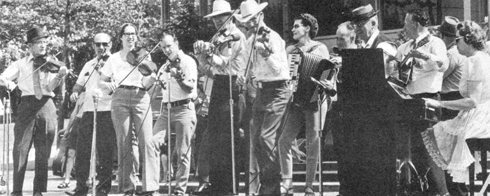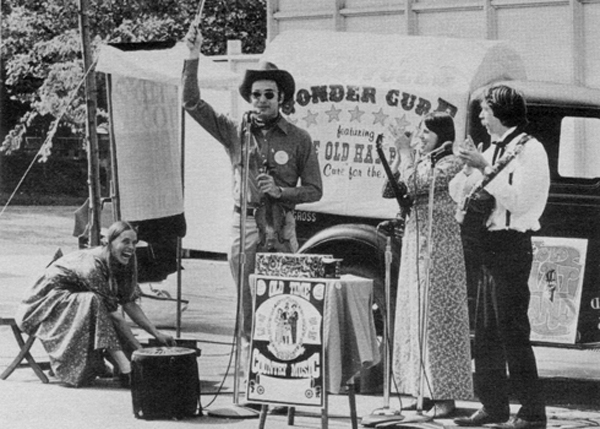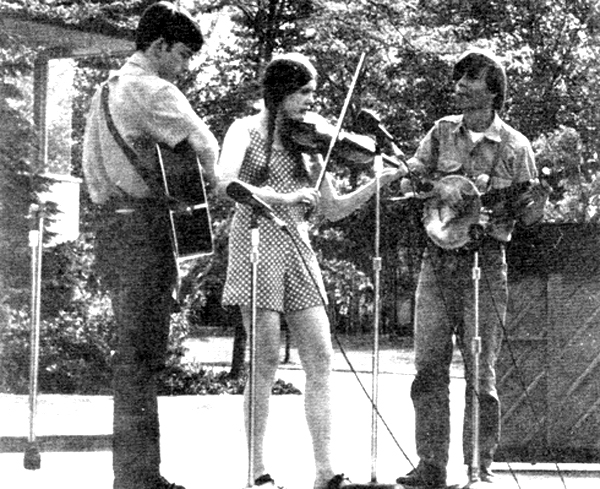
As the 46th Annual Northwest Folklife Festival gets ready for a new run this Memorial Day weekend it is interesting to look back to its beginning in 1972. Today with a budget of $1.3 million and over 5,000 artists performing on 25 stages it’s hard to realize that this festival had a very humble beginning. From some early Journals from the Seattle Folklore Society we can appreciate its roots and history.
A Traditional Folk Festival for Seattle? Reprinted from the Seattle Folklore Society Journal Vol. 3, No. 2, Dec. 1971
The National Park Service and the National Folk Festival Committee have proposed a regional festival of traditional music, dance, and folk arts to be held in Seattle near the end of May 1972, providing sufficient local interest is shown in organizing and financing the endeavor. Discussions have been undertaken here with the Seattle Center, representatives of the Seattle Folklore Society, and Scandia Folk Dance Society and others as to the feasibility of such a festival and the degree of local cooperation which could be expected. The consensus at this time is that such a festival is feasible, but that it will take a fair amount of voluntary manpower and some funding to become a reality.
Personnel and agencies involved in the discussion so far have shown enthusiasm for the project and a general outline for such an event is being formulated now. In general, the festival would concern itself with ethnic folk arts found in the Northwest, including Alaska and British Columbia, and would include representation from the various ethnic groups found in the region, both domestic and foreign. The emphasis would be on traditional folk arts as practiced from day to day, rather than commercial “folk music” or “folk dancing,” and would give people from the area an opportunity to see the rich heritage of traditional arts present in the area which generally are not given exposure thru the mass media.
Two major problems exist at this point – funding, and a staff able to devote the time required for organization. The National Park Service and the National Folk Festival Committee, while providing assistance in coordination and securing of facilities, have limited funds for festival use. Co sponsorship of the event by private industry has been approved, and some sources of private funding are currently being explored. If funding can be arranged, it is believed a full time coordinator could be hired for the project.
If you have any suggestions concerning things which could he included in such a festival, sources of funding, or desire to offer assistance in making such a festival a reality, we would like to hear from you. The local coordinators at this time are: Charles J. Gebler, Public programs officer, National Park Service, 4th & Pike Building, Seattle 98101, phone 442 5201; Gordon E. Tracie, Scandia Folk Dance Society, 4220 9th N.E., Seattle 98105, ME3 4225; Philip L. Williams, 424 3Sth Ave., Seattle 98122, EA3 1112.
The First Northwest Regional Folklife Festival May. 26 299 1972. By Andy Wallace. Reprinted from the Seattle Folklore Society Journal Vol. 3, No. 4, June, 1972
What? Four days of clear skies in Seattle at this time of year? Never happen. But it did. Obviously, the Northwest Folklife Festival had the sanction of higher powers than the National Folk Festival Association to cause this phenomenon, but we were in there helping. And a fine festival it was.

It all started back last December when Andy Wallace, our intrepid field organizer, went out to Seattle and presented the idea of a festival to the Seattle Center, the Seattle Folklore Society, and the National Park Service. Several months and many ups and downs later the festival was a reality, thanks to the devotion and hard work of the aforementioned and a wonderful organization called REACH, dedicated to the elderly, who accomplished the bulk of the coordination.

The scope of the festival was impressive, with musicians and dancers from Washington, Oregon, Idaho, and Alaska taking part in the four day festival. Five staging areas held continuous activities from 2 pm til 10 pm Saturday thru Monday, with an additional area devoted to crafts traditional to the area. The festival got off to a fine start Friday evening with music by the Tall Timber String Band, and the Edmonds Senior Citizen Band, and then moved out to the beautiful mural amphitheater for a sampler concert featuring fiddlers, Scottish Highland dancing, the Cape Fox Indians, and the exciting Oinkari Basque Dancers from Boise, Idaho. And so it was throughout the. weekend – good weather, good music and dance, and appreciative crowds – 123,000 strong. Saturday and Monday night concerts in the Center’s fine playhouse both had turn away crowds, and were well balanced, representative performances.
I wish that there were space to mention all of the fine groups and individuals who took part in the festival and assured it success. Most all of the rich ethnic heritages of the Northwest were represented – Scandinavian, Scottish, Irish, Japanese, German, Polish, French, Balkan, Basque, and more. The old time fiddlers turned out en masse and did much to set the carefree, traditional flavor of the event, filling in all over the grounds. There was also plenty of fine singing in the Northwest Festival Court, and despite several pow wows that weekend, the native peoples were well represented by the Cape Fox Tribe, Chief Antelope and the King Island Eskimos, one of the real treats of the festival for me. Other personal favorites were the Oinkari Basque Dancers, the fiddling of Benny Thomason and Joe Pancerzewski, the Rhodesian Dancers, the inimitable Old Hat Band, and a remarkable string band called Granny Lamb & the Old Timers, whose median age was fifteen!
It would take many pages to really do justice to all that was seen and heard at the Festival. Once again, many thanks to Dave Lempesis and the Seattle Center, to Tom Parks of REACH, to Phil and Vivian Williams, John Burke, Charlie Gebbler of the Northwest Regional Office of the National Park Service, and all those whose hard work paid off with dividends. Most gratifying of all was the feeling that we’ve barely scratched the surface of traditional talent in the Northwest. And we’ll get another chance – for at the end of the Festival it was announced that the Memorial Day Weekend has already been set aside by the Seattle Center for the Second Northwest Folklife Festival. It was an auspicious beginning for the NFFA’s Northwest Regional Festival, and promises to be even better next year.
Second Annual Northwest Regional Folklife Festival, Seattle Center, Seattle, Washington, May 25-28, 1973. Reprinted from the Seattle Folklore Society Journal, Vol. 4, No. 3, March, 1973
The Second Annual Northwest Regional Folklife Festival will be held at the Seattle Center, Seattle, Washington, on May 25, 26, 27 and 28, 1973, under the sponsorship of the National Park Service, the Seattle Center, REACH Inc., the National Folk Festival Association, and the Seattle Folklore Society. The Northwest Folklife Festival Association has been formed as a non profit, civic corporation to conduct the festival.
The purpose of the festival is to present a broad spectrum of ethnic and traditional music, dance, arts and craft skills found in the Northwest region – Washington, Oregon, Idaho, and Alaska. Emphasis is placed on what people in the region do to entertain themselves and what they make for their own use.
The 1972 folklife festival was the first such event held in the Northwest, and despite the fact that it was organized in less than one month, presented over 380 performers or craftsmen and attracted an attendance of over 120,000 persons The last festival featured many dance groups from ethnic communities in the Northwest such as the Oinkari Basque Dancers from Idaho, Scottish and Irish dancers, and Scandinavian dancers; the Washington Old Time Fiddlers, several bluegrass and oldtime string bands, the Cape Fox Eskimo Dancers, Herman Bischofberger making violins, needlework crafts, Swiss bands, a balalaika trio, scores of contemporary and traditional folksingers, a barbershop quartet, a traditional jazz band, a senior citizens “kitchen band”, audience participation folk dancing, and Koleda, just to name a few of the types of participants. Much credit for the rapid coordination of the 1972 festival and for its success must be given to Tom Parks of REACH, the festival coordinator, Dave Lempesis of the Seattle Center, Darrel McMichael of the Folklore Society, Charles Gebler of the National Park Service, and Andy Wallace of the National Folk Festival Association. The 1972 festival also was made possible only through the very generous contribution of time and skills by the participants and many other coordinating personnel, none of whom were paid as the festival had but a miniscule budget. There is no admission charge for any festival event.
The Seattle Folklore Society as one of the sponsoring organizations has made a commitment to furnish certain services in connection with the1973 festival. As this festival is also being operated on a limited budget, it will succeed only if the people who believe in the value of this type of event contribute their time and efforts into making it succeed. The Society and the Festival Association are interested in hearing from persons who wish to participate in the festival, either as performers or as production assistants.
The Society has agreed to operate information services at the festival and needs persons to man information booths and provide festival guide services for visitors We also need persons familiar with folklore areas represented at the festival to act as performance area moderators and coordinators. The performance area moderators may be required to introduce some of the performers and give some background information on the presentation. They will also be responsible for monitoring the programming in the area, making sure the next scheduled performers are ready, and if not, arranging a substitute with the festival program staff. This latter job can be a major task at a voluntary participation festival of this size as schedules are sometimes difficult to maintain.
The Society also will be responsible for the festival program, which for this year, to the extent of available printing funds, will feature articles on Northwest folklore and related topics as well as the schedule of events. The Society’s Journal staff needs writers, artists, photographers, typists, and advertising solicitors. The Journal also would like reporters and photographers for coverage of the festival.
The festival is held throughout the Seattle Center grounds with events going on all day at several different locations. This year there will be an ”open mike” folksinging area, one or two folk dance platforms, a string band area, an arts and crafts building, an old time fiddlers area, a multi purpose stage area, an Indian dance area, and the Playhouse and Opera House for events requiring these facilities. The festival committee would like sufficient participation to operate all these areas from 2 p.m. to 10 p.m. each day.
Anyone interested in participating in the Festival in any capacity should contact one of the following persons: *Director: REACH, Tom Parks, 3603 S. Alaska St., Seattle WA 98118, 206 PA5-1610 *Personnell Coordinator: Darrel McMichael, P.O. Box 3034, Seattle WA 98114, 206 LA4 1110 or LA5 4280 *Festival Office: Seattle Center, Dave Lempesis 303 Harrison St., Seattle WA 98109, 206 583 2541 *Seattle Folklore Society: The Folkstore, Thane Mitchell, 5236 University Way N.E., Seattle WA 98105, 206 LA4 1110 *Seattle Folklore Society President: John Ashford, 1812 NE 58th, Seattle WA 98105, 206 LA5 5007 *Seattle Folklore Society Journal Editor: Vivian Williams, 424 35th Avenue, Seattle WA 98122, 206 323 1112
*Volunteer Service Coordinator: Dr. Loren Rex, 2339 Robinhood Drive, Edmonds WA 98020, 206-LA4 7500 *Folk Dance Coordinator: Gordon Tracie, 4220 9th Ave. N.E., Seattle WA 98105, 206 ME3 4225 * Festival Association Chairman: Philip L. Williams, 424 35th Avenue, Seattle WA 98122, 206 323 1112 *Oregon State Festival Advisory Board Members: Portland: Ian Joel, Fiddle & Banjo Shop, 6229 S.E. Milwaukee Ave., Portland, Oregon 97202, 503 221 0111 Eugene: Barry Tolkien, English Department, University of Oregon, Eugene, Oregon 97403.
The Forty-Sixth Annual Northwest Regional Folklife Festival, Seattle Center, Seattle, Washington, May 26-29, 2017.
After forty-five years has the current Festival become too big? Has it moved too far from it’s historical roots? Is it time for re-invention or a new direction? I’ll let you decide. Stewart Hendrickson

“I wish that there were space to mention all of the fine groups and individuals who took part in the festival and assured it success.”
But that’s what I want to know, because I think I was one of them–definitely ’72 or ’73. Where can I find the list?
Great article! Thanks for the memories.